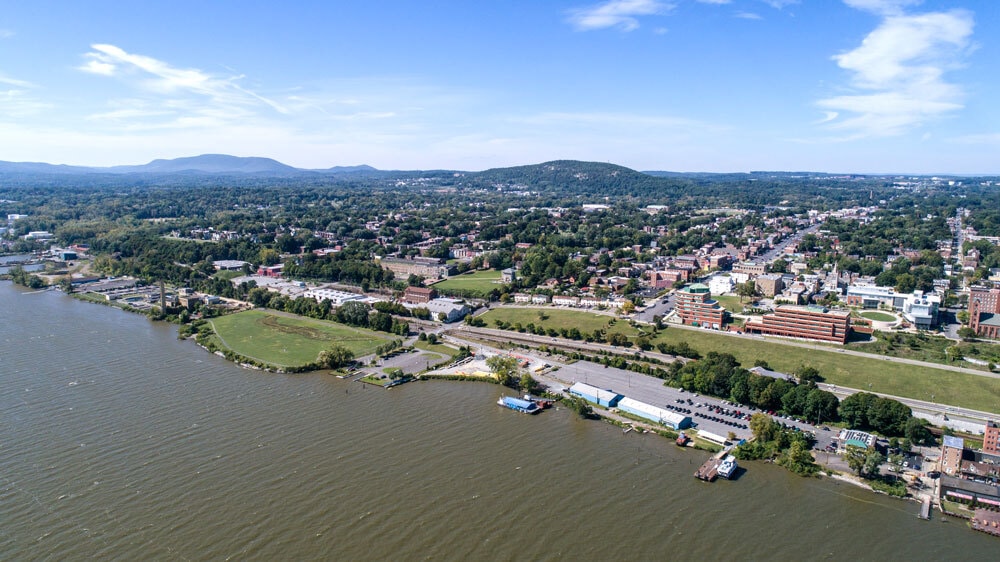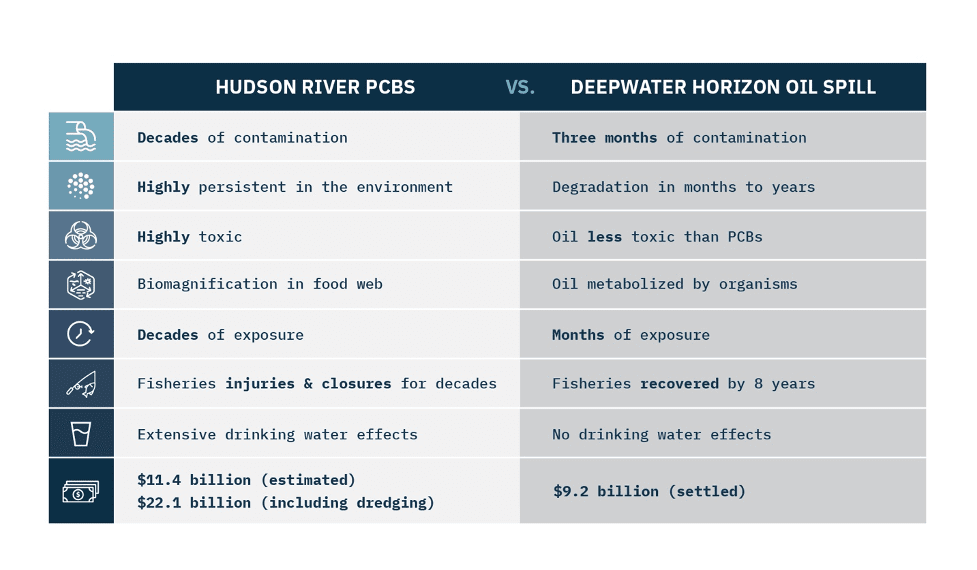New Report Estimates Billions in Damages for Devastating Contamination of the Hudson River

For Immediate Release
Contact:
Hayley Carlock hcarlock@scenichudson.org; 845 891 3148
Report from Leading Experts Documents that High Levels of PCB Contamination Continue to Damage 200-mile Stretch of the Hudson River
Contamination Disproportionately Harms Low-Income and Immigrant Communities That Subsist on Hudson River Fish
View Report Here
HUDSON VALLEY – Today, Scenic Hudson released a breakthrough report from leading natural resource damages (NRD) experts estimating the potential magnitude of damages for harm to Hudson River natural resources caused by General Electric’s toxic Polychlorinated biphenyl (PCB) contamination at $11.4 billion. GE dumped millions of pounds of toxic PCBs into the Hudson River between 1947 and 1977―contaminating a 200-mile stretch of the Hudson from upriver factories to New York Harbor. The report evaluates existing data and previous reports to estimate the dollar amount of the natural resource damages. The 200-mile stretch of the Hudson River is one of the largest Superfund sites in the nation.
The report also estimated the cost of additional dredging in the Upper Hudson River to prevent further injury to natural resources at $10.7 billion. This additional dredging is necessary to address significant PCB contamination remaining in river sediments that will continue to cause harm to wildlife and communities along the river for many decades if not removed. The goal of dredging would be the reduction of PCB concentrations in Hudson River fish to levels that would be safe for consumption and accelerate the reduction of risk to other natural resources. Restoration dredging could potentially reduce the compensatory damages owed by GE by reducing the timeframe that the injuries will continue into the future. When taken with the cost needed to address the past and ongoing impacts on wildlife and communities along the Hudson River, GE could be liable for as much as $22 billion in total damages.
“GE’s contamination has caused 70 years of harm, that is expected to last another 50 years or more into the future. Hudson River Trustees have documented PCB pollution of drinking water, fishery closures and fish consumption restrictions, compromised river navigation in marinas and canals, and threats to the health of waterfowl and mammals. After a thorough review of these studies, we have concluded that the Hudson has suffered adverse impacts at historic levels—estimated at $11.4 billion,” said Dagmar Schmidt Etkin, Ph.D., principal of Environmental Research Consulting and one of the report authors.
Federal Superfund law requires a polluter to both clean up the contamination and compensate for the past and ongoing injuries to natural resources. Federal and State trustees initiate the natural resource damage process by conducting a full assessment of the impacted area, with reports issued on the extent of injuries and recommend restoration actions. The parties responsible for the assessed damages are then liable for the cost of restoration and replacement projects.
The report is not a Natural Resource Damage Assessment, which may only be conducted by the designated Trustees. This analysis applied established NRDA procedures and used publicly available data and studies to provide a credible framework for assessing the damages GE could owe.
“The people of the Hudson River Valley and visitors from across the nation have suffered for seven decades from pollution of the river and surrounding habitat by GE’s PCBs, and the damage will continue for decades more. A once-vibrant commercial fishery closed overnight in 1976, and health officials continue to advise all people to severely restrict or avoid consumption of Hudson River fish,” said Hayley Carlock, Scenic Hudson Director of Environmental Advocacy and Legal Affairs, “This first-of-its-kind report puts an estimated $11.4 billion dollar value on the damage GE’s PCBs have caused. We’re calling on NRD Trustees to negotiate a settlement with GE that will provide for the restoration of the river. The company should step up to compensate for its decades of pollution and lay the groundwork for clean drinking water supplies, healthy habitats, safe public access to the river for all and revitalized ecotourism.”
PCBs contaminate every layer of the river’s ecosystem, including many species of fish that subsistence anglers rely on for food. While the New York State Department of Health (NYSDOH) remains engaged in a decades-long initiative to warn anglers against eating contaminated fish from Hudson Falls to the Battery in New York City, a 2016 snapshot survey by Scenic Hudson and Sierra Club found that of anglers who consumed fish, 32% reported eating them in quantities exceeding NYSDOH guidelines. Of that group, Latino anglers reported the highest rate of fish consumption (64%), followed by African Americans (41%).
“Many low-income and immigrant populations in the Hudson Valley rely on the river to feed their families. The longer we delay PCB clean up, the more we are harming our low-income Black Indigenous and People of Color communities,” said Aaron Mair, Director of the Forever Adirondacks Campaign. “General Electric must restore the resources of the Hudson River and protect public health of all people.”
The Hudson River is one of the largest Superfund sites in the country, and it touches some of the nation’s most densely populated areas. While it is challenging to find a comparable Superfund site, the $9.2-billion NRD settlement in the Deepwater Horizon oil spill in the Gulf of Mexico covered a comparable area in square miles. While that was an oil spill and not PCB contamination, the NRD process was comparable to that for the Hudson River and serves as a reference for valuing the level of compensation that would be fair and appropriate for the Hudson. Though the impacts to the Gulf of Mexico from the Deepwater Horizon spill were devastating, the report concludes that injuries caused to the Hudson by GE’s PCBs are far more extensive and long lasting. Below is a chart that compares the impact of PCBs in the Hudson River and the Deepwater Horizon Oil Spill.

“11.4 billion dollars may cover the huge amount of past and ongoing damage to the Hudson River’s world-class natural resources, but that does not account for the increases in cancer, the reduction of IQ, and the many other diseases that have occurred — and are still occurring — in people who live near the Hudson. It’s bad enough that those who must consume the river’s fish, despite health advisories, to have adequate food to eat suffer from these dire health threats. It’s even worse that anyone who breathes the water’s polluted vapors also is at great risk. That’s why it’s absolutely imperative to rid the river of these toxins once and for all,” said David O. Carpenter, M.D., Director, Institute for Health and the Environment, University at Albany.
“The Hudson River flows from bucolic farms and forest to our nation’s great New York City. In a day when the worlds resources are dwindling, the standards for those responsible for its restoration should not be diminished or discounted,” said Gil Hawkins, Past President, Environmental Director, Hudson River Fisherman’s Association. “A comprehensive Hudson River NRD settlement could hasten the river’s recovery from toxins, making it possible sooner, instead of decades from now, to safely eat the river’s fish. This would not only be good news to the many families who fish for sustenance, but to regional businesses. Recreational fishing has contributed to the economy of the entire river. The complete cleanup and restoration of the river resources would speed up and expand these benefits — as well as long-cherished waterfront traditions such as fish bakes and festivals — for people and communities all along the river.”
The Hudson River Natural Resource Damage Assessment should provide the people of New York the resources to restore the Hudson to its condition before GE’s PCB contamination by:
- Implementing restoration projects that foster new recreation and ecotourism opportunities
- Helping restore the Hudson’s once vibrant fisheries
- Ensuring Hudson River fish are safe to consume and end reliance on consumption advisories that do not protect subsistence fishing communities
- Eliminating threats to drinking water and additional costs to filter PCBs from supplies;
- Healing the river’s environment with substantive natural resource improvements
About Scenic Hudson
Scenic Hudson preserves land and farms and creates parks that connect people with the inspirational power of the Hudson River, while fighting threats to the river and natural resources that are the foundation of the valley’s prosperity.
About the Report Authors
Deborah French McCay, Ph.D. (RPS Ocean Science) specializes in quantitative assessments and modeling of aquatic ecosystems and populations, oil and chemical transport and fates, and biological response to pollutants. She has developed water quality, food web and ecosystem models for freshwater, marine and wetland ecosystems. She is an expert in modeling oil and chemical fates and effects, toxicity, exposure and the bioaccumulation of pollutants by biota, along with the effects of this contamination. Her population modeling work includes models for plankton, benthic invertebrates, fisheries, birds and mammals. These models have been used for impact, risk and natural resource damage assessments, as well as for studies of biological systems. She led the development of natural resource damage assessment (NRDA) models established in the 1996 U.S. Federal regulations under CERCLA and the Oil Pollution Act, evaluating restoration strategies and bioeconomic valuations in marine and freshwater environments. She has provided expert testimony in hearings regarding environmental risk and impact assessments. She has over 30 years of experience in analyzing oil spills and is considered one of the leading international experts on the fate and effects of oil and chemical spills.
Gretchen Greene, Ph.D. (Greene Economics, LLC) has over 25 years of diverse economics experience in natural resource, energy, and community economics. Dr. Greene has expertise in ecosystem service valuation, natural resource damage assessment (NRDA), recreation, water demand and management and public infrastructure investment. She also brings expertise in endangered species economics; land conservation and sustainable economic development; cost-benefit analysis; demographics, socioeconomics and environmental justice; decision analysis with uncertainty; and survey design and data analysis. An experienced facilitator, Dr. Greene has developed focus groups and surveys covering a variety of environmental topics. She has worked in dozens of different cultural environments, from southern Africa to Mongolia to Native American communities. She has worked with numerous federal, state, tribal and municipal agencies as well as private industrial clients and law firms. Dr. Greene has a BA in Religious Studies from Wellesley College, an MS in Food and Resource Economics from the University of Florida, and a Ph.D. in Food and Resource Economics from the University of Florida.
Dagmar Schmidt Etkin, Ph.D. (Environmental Research Consulting) has 45 years of experience in environmental analysis–14 years investigating issues in population biology and ecological systems, and 31 years specializing in the analysis of oil spills. Since 1999, she has been president of Environmental Research Consulting (ERC) specializing in environmental risk assessment and spill response and cost analyses. She has been an oil spill consultant to the US Coast Guard, EPA, NOAA, Army Corps of Engineers, the Bureau of Ocean Energy Management, the Bureau of Safety and Environmental Enforcement, various state governments, the Canadian government, the oil and shipping industries and non-governmental organizations. She is internationally recognized as a spill expert and has been a member of the UN/IMO/UNEP/UNESCO Joint Group of Experts on the Scientific Aspects of Marine Environmental Protection (GESAMP) since 1997. She received a BA in Biology from the University of Rochester, and MA and Ph.D. degrees from Harvard University in Organismic/Evolutionary Biology, specializing in ecological modeling and statistics.

